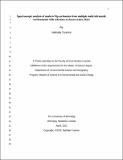| dc.contributor.author | Turenne, Nathalie | |
| dc.date.accessioned | 2023-08-22T19:39:42Z | |
| dc.date.available | 2023-08-22T19:39:42Z | |
| dc.date.issued | 2023-04 | |
| dc.identifier.citation | Turenne, Nathalie. Spectroscopic analysis of modern Mg-carbonates from multiple mafic/ultramafic environments with relevance to Jezero crater, Mars; A Thesis submitted to the Faculty of Grad[uate] Studies in partial fulfillment of the requirements for the ... Master[] of Science in Environmental and Social Change..., Department of Environmental Science and Geography, The University of Winnipeg. Winnipeg, Manitoba, Canada: University of Winnipeg, April, 2023. DOI: 10.36939/ir.202308221437. | en_US |
| dc.identifier.uri | https://hdl.handle.net/10680/2103 | |
| dc.description.abstract | The detection and presence of carbonates on Mars and within Jezero crater implies and supports an extensive aqueous history during the Noachian to early Hesperian and can help with the reconstruction of paleoenvironments. Mg-carbonates have been identified using in-situ spectroscopic instruments on board the Mars Perseverance Rover in the mafic and ultramafic Máaz and Séítah units implying a potential past habitable environment. The goal of this study was to conduct a multi-instrument examination of magnesium carbonates formed at several terrestrial ultramafic and mafic sites and assess their relevance to the exploration of Jezero crater on Mars. In this study we demonstrate the unique spectral features using a suite of spectroscopic instruments of the microbialite samples from the Atlin playas, Clinton Creek, Lake Alchichica, and Lake Salda analogue sites with relevance to Mars. The results of this study determined the presence of magnesite, hydromagnesite and aragonite being the dominant mineralogy present. The reflectance was determined to be the most useful spectroscopic instruments to identify biological compounds while the Raman was determined to be most useful at identifying mineralogy and comparing the microbialites to pure end members. From our study we have determined the likely hypotheses for the current state of the Jezero crater bedrock to be consistent with hydrothermal alteration and hypothesize lacustrine environments for the formation of Marginal Carbonate unit. The use of analogue sites can help to indicate the habitability of Mars and that the most successful determinant of Mg-carbonate formation on Mars is to return the samples to Earth for further analysis. | en_US |
| dc.language.iso | en | en_US |
| dc.publisher | University of Winnipeg | en_US |
| dc.rights | info:eu-repo/semantics/openAccess | en_US |
| dc.subject | Mars | en_US |
| dc.subject | Microbialites | en_US |
| dc.subject | Carbonates | en_US |
| dc.subject | Spectroscopy | en_US |
| dc.subject | Jezero crater | en_US |
| dc.title | Spectroscopic analysis of modern Mg-carbonates from multiple mafic/ultramafic environments with relevance to Jezero crater, Mars | en_US |
| dc.type | Thesis | en_US |
| dc.description.degree | Master of Science in Environmental and Social Change | en_US |
| dc.publisher.grantor | University of Winnipeg | en_US |
| dc.identifier.doi | 10.36939/ir.202308221437 | en_US |
| thesis.degree.discipline | Environmental Science and Geography | |
| thesis.degree.level | masters | |
| thesis.degree.name | Master of Science in Environmental and Social Change | |
| thesis.degree.grantor | University of Winnipeg | |

